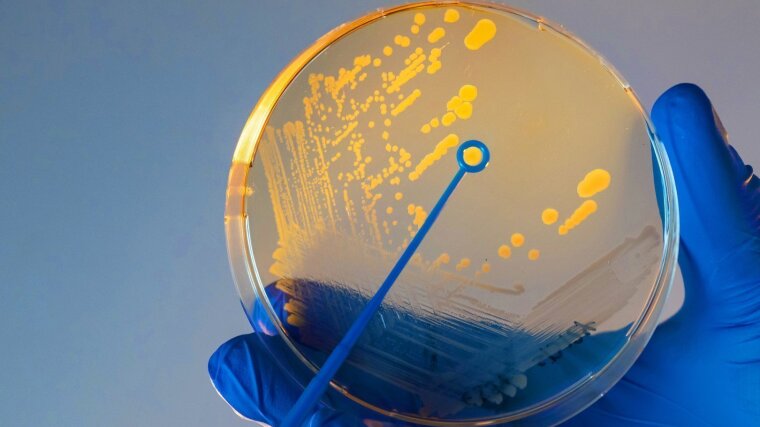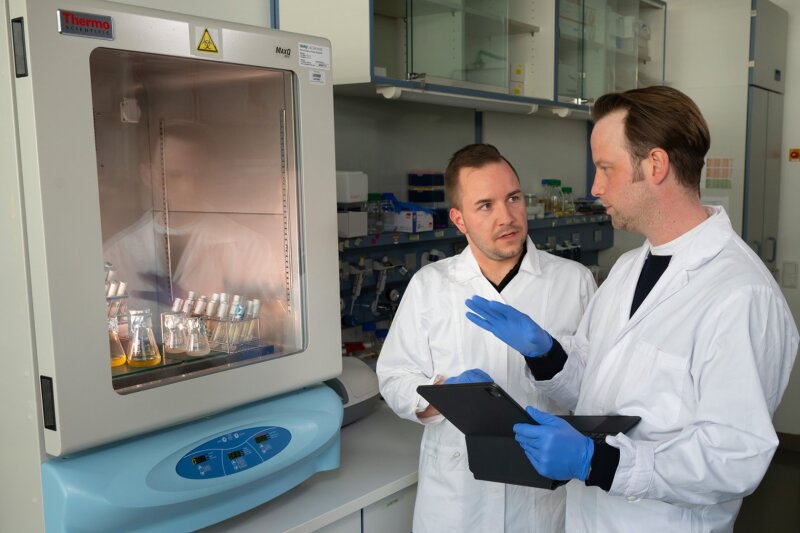
Bacteriophages—viruses that proliferate by using bacteria as hosts—are the most abundant entities on Earth. They persistently penetrate single-cell bacteria and seize control of them. However, the bacteria are by no means defenceless against their attackers, developing defence mechanisms to which phages must then respond. Not only does this arms race provide fascinating insights into the microbiome, it could also offer a tool to tackle the rising tide of antibiotic resistant bacteria.
By Sebastian Hollstein
For millions of years, a near-invisible war has been waged here on Earth. All around us, on us and even within us, bacteriophages are attempting to penetrate bacteria and exploit them for their own ends. This is because, like all viruses, phages do not possess metabolic abilities, making them reliant on a host organism to proliferate. Lytic phages destroy their hosts after producing sufficient numbers of progeny. By contrast, lysogenic phages live and reproduce over a prolonged period within the host cell.
As dangerous as attacks from bacteriophages (literally: »bacteria eaters«) are for the single-cell victims, they are also pivotal for bacterial development. »Phages play a major role in microbial evolution because, as they proliferate, their genome also incorporates genetic material from the host. If the new phage penetrates a different bacterium, it can integrate this information into the new host’s DNA,« explains Prof. Dr Kai Papenfort from the Cluster of Excellence »Balance of the Microverse«, which engages intensively with viruses. »By means of specific mechanisms, the cell processes this input and suddenly gains new abilities—which opens the door to huge evolutionary leaps.«
Microbiome-based espionage
In the eternal battle against phages, however, bacteria are by no means defenceless. Instead, they are constantly developing defence mechanisms that, when decrypted, can be exceptionally valuable for biotechnology. This enables them, for example, to identify and destroy specific incoming phage DNA—which prevents the phage from proliferating. »The discovery of this mechanism revolutionized molecular biology. Without it, genetic engineering techniques like the CRISPR/Cas genetic scissors would not have been possible,« says Papenfort.
However, the phages are also flexible and develop responses to bacterial defence strategies. Some methods sound like secret service strategies—as Kai Papenfort and his team observed in experiments that pitted the bacterium Vibrio cholerae against the phage VP882.
»Whether phages display lytic or lysogenic behaviour in a cell depends on how many bacteria—and, therefore, how many potential hosts—are in the vicinity,« he explains. »To determine this, the phages listen in on the communication between bacteria.« This is because the single-cell organisms use »quorum sensing« in which they emit specific signal molecules to other bacteria in their surroundings.
This way, members of the same population are able to act as a group and coordinate collective actions, such as forming a biofilm. If, after penetrating a bacterium, a phage detects sufficient numbers of signal molecules, it initiates a mechanism that suppresses the host’s normal activities and promotes its own proliferation. After producing enough
progeny, the virus destroys its host and releases new phages to infect neighbouring bacteria.
At the same time, however, the researchers discovered that the bacterium also activates genes designed to impede phages and thwart its own destruction. In Papenfort’s view, this is a precursor to the immune system in more developed organisms. In the course of their experiments, the Jena-based researchers identified for the first time the ability to control both attack and defence with regulatory RNA molecules.
Phage therapy instead of antibiotics
Such research results help us to better understand phages and phage-host interactions and, potentially, deploy them for medical purposes. In some countries, phages have been used to fight infections for decades—primarily because they are cheaper and more readily available than antibiotics.
In an effort to gain greater control over this technique and apply it with even greater precision, researchers are now developing synthetic phages. »A virus is a relatively simple biological structure,« explains Kai Papenfort. »As a result, we can produce viruses easily in the lab and tailor them for specific applications.«
Unlike broad-spectrum antibiotics, phages can zero in on specific bacterial pathogens without damaging the entire microbiome. For one thing, phage therapies would be a step towards less invasive, personalized medicine. For another, they would counteract the growing spread of antibiotic resistant bacteria.
Prof. Dr Kai Papenfort (right) and Dr Marcel Sprenger (left) discuss the results of the research in front of a shaker-incubator.
Image: Jens Meyer (University of Jena)